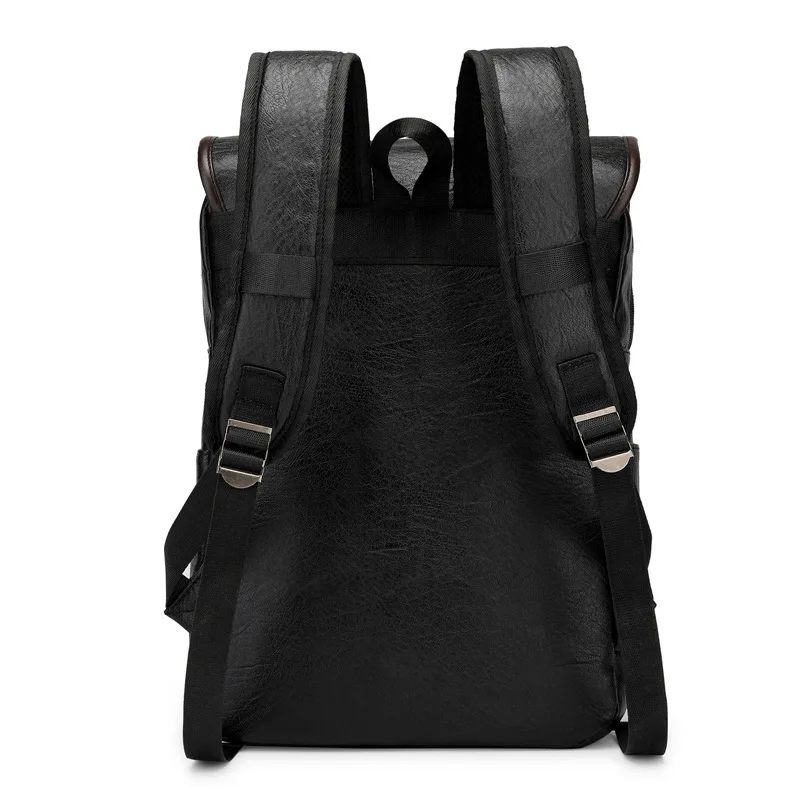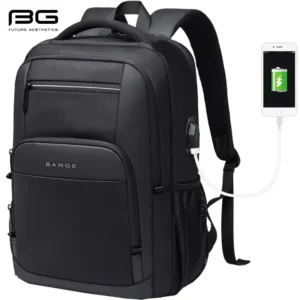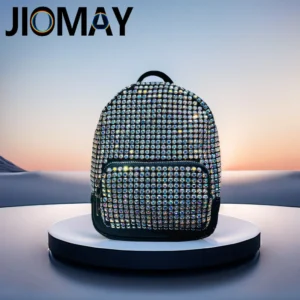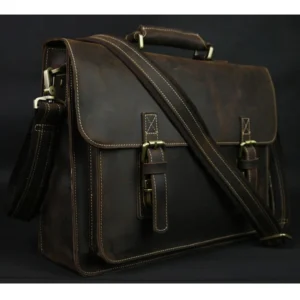Introduction
When it comes to travel companions, few options match the perfect blend of functionality and style offered by a well-crafted leather backpack. A truly “travel-ready” leather backpack isn’t just any bag with straps – it’s a thoughtfully designed piece that combines durability, organization, and versatility to meet the unique demands of life on the move.
In recent years, these sophisticated carriers have gained tremendous popularity among travelers who want both practicality and aesthetic appeal. The allure is understandable: unlike their synthetic counterparts, quality leather backpacks often look better with age, developing a unique character that tells the story of your journeys. With proper care, a premium leather backpack can faithfully serve you for well over a decade, making it both a practical tool and a worthy investment.
Whether you’re a frequent business traveler, weekend adventurer, or planning extended journeys, selecting the right features can make all the difference in your travel experience. This guide will walk you through everything you need to know about leather conditioning and waterproofing techniques, material quality considerations, organization systems, comfort features, and much more – helping you find the perfect leather travel backpack for your specific needs.
The Enduring Benefits of Leather Backpacks for Travel
Unmatched Durability and Longevity
What truly sets leather backpacks apart is their exceptional ability to withstand the rigors of travel. Unlike synthetic materials that fray, tear, or fade quickly, quality leather actually strengthens with proper use and care. This natural material offers:
- Superior resistance to abrasions and punctures
- Ability to withstand frequent handling and loading
- Natural flexibility that prevents cracking at stress points
- Structural integrity that maintains shape over years of use
The difference in longevity is striking – while synthetic backpacks typically need replacement every 2-3 years with regular use, a well-maintained leather backpack can easily last 10+ years or more. This durability makes them ideal companions for travelers who demand reliability from their gear. Proper conditioning techniques for leather backpacks significantly extend this lifespan even further.
Timeless Style and Aesthetic Versatility
One of the most compelling advantages of leather backpacks is their remarkable versatility across different travel contexts. A quality leather backpack transitions seamlessly from a business meeting in Tokyo to a casual café in Paris, or from an airport lounge to a weekend hiking trip. This chameleon-like adaptability means you won’t need multiple bags for different aspects of your journey.
The classic aesthetic of a well-designed leather backpack complements virtually any travel wardrobe, from business attire to casual wear, eliminating the need to switch bags based on outfits or occasions. This versatility is particularly valuable for travelers who move between different environments within a single trip.
The rich character and subtle elegance of full-grain leather backpacks make them appropriate in virtually any setting, from upscale hotels to rustic destinations.
Investment Value and Patina Development
Unlike mass-produced synthetic bags that deteriorate with age, quality leather backpacks develop a beautiful patina over time – a natural luster and coloration unique to each bag based on how you use it. This patina tells the story of your travels, with each mark and subtle color change representing a different journey or adventure.
The development of this character means vintage leather backpacks often become more appealing with use rather than less, creating a personalized aesthetic that can’t be manufactured. This aging process transforms your backpack into both a practical tool and a visual record of your travels.
Natural Weather Resistance with Proper Treatment
With appropriate care, leather offers good resistance to light rain and varying weather conditions. While no untreated leather is completely waterproof, quality leather naturally repels light moisture and can be enhanced with proper treatments to improve this resistance.
The key is understanding how to prepare and maintain your backpack for different travel environments. Regular application of quality leather conditioners and waterproofing agents creates a protective barrier against moisture while maintaining the leather’s breathability and flexibility. Learning comprehensive waterproofing techniques for leather bags ensures your backpack remains protected through changing weather conditions during your travels.
Key Features to Look for in a Travel-Ready Leather Backpack
Finding the perfect travel leather backpack requires understanding which features truly enhance your journey and which are merely marketing gimmicks. The ideal combination of features depends on your specific travel style, destinations, and carrying needs. However, certain key elements are universally important in determining the exceptional benefits of sturdy leather backpacks designed for travel.
When evaluating options, consider how these features work together as an integrated system rather than isolated elements. A backpack with superior organization but poor comfort features may seem perfect in the store but become unbearable during a long travel day. Similarly, a comfortable bag without adequate security features might leave you vulnerable in unfamiliar locations.
Material Quality and Construction
The foundation of any great travel backpack starts with material selection and construction techniques. These fundamental elements determine not just how long your backpack will last, but how it performs under stress, maintains its appearance, and protects your belongings throughout your journeys.
When examining carry-on leather backpacks, pay close attention to the quality indicators that separate exceptional products from mediocre ones. These details often explain price differences between seemingly similar options.
Types of Leather: Finding the Right Balance
Not all leather is created equal, and understanding the differences is crucial when investing in a travel backpack:
Full-Grain Leather: The highest quality option, made from the top layer of the hide with all natural grain intact. Extremely durable, develops rich patina, and offers the best longevity, though typically heavier and more expensive.
Top-Grain Leather: The second-highest quality, with the outermost layer sanded to remove imperfections. More uniform in appearance than full-grain, lighter weight, and still very durable, making it an excellent balance for travel bags.
Genuine Leather: Despite the name, this is a lower quality grade made from layers below the top and grain splits. Less durable and less breathable, though less expensive.
Bonded Leather: The lowest quality option, essentially leather particles glued together. Avoid for travel backpacks as it deteriorates quickly with regular use.
| Leather Type | Durability | Weight | Water Resistance | Relative Cost | Patina Development |
|---|---|---|---|---|---|
| Full-Grain | Excellent | Heavy | Good (with treatment) | Highest | Exceptional |
| Top-Grain | Very Good | Medium | Good (with treatment) | High | Good |
| Genuine | Fair | Light | Poor | Moderate | Limited |
| Bonded | Poor | Light | Very Poor | Low | None |
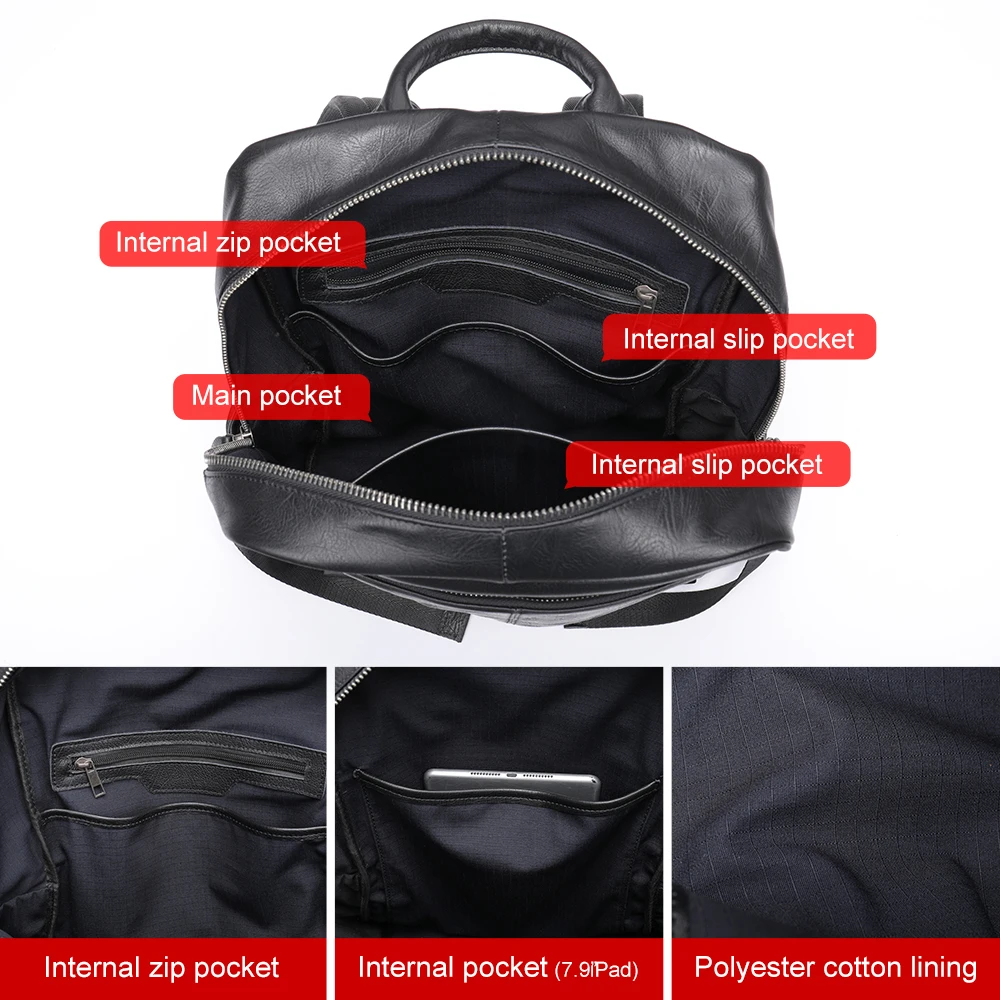
Tanning Processes and Their Impact on Performance
The method used to turn raw hide into leather significantly affects how your backpack performs during travel:
Vegetable-Tanned Leather: Uses natural tannins from plants and bark. Creates firmer, more structured leather that develops rich patina over time. More environmentally friendly but typically heavier and less water-resistant initially.
Chrome-Tanned Leather: Uses chromium salts for processing. Produces softer, more flexible leather that’s naturally more water-resistant. Lighter weight makes it popular for travel bags where weight matters.
Understanding these differences helps you select a backpack suited to your specific travel environments. For frequent travelers in varied conditions, learning DIY leather care for travel backpacks becomes essential for maintaining performance regardless of tanning method.
Hardware and Fastenings: The Unsung Heroes
The quality of a backpack’s hardware often determines its longevity in travel conditions:
Zippers: Look for YKK or other reputable brands with self-healing functionality (ability to realign teeth if they separate). Metal zippers offer better durability than plastic for main compartments.
Buckles and Closures: Solid brass or high-quality nickel hardware resists breaking under stress. Test all buckles for smooth operation and secure fastening.
Rivets and Reinforcement Points: Examine stress points like handle attachments and strap connections for proper reinforcement with quality hardware.
Stitching: Double or reinforced stitching at stress points indicates quality construction that will withstand the rigors of travel.
Understanding various types of closures for leather backpacks helps you select features appropriate for your security needs and usage patterns.
Internal Lining and Protection
The inside of your leather backpack is just as important as the exterior:
Quality Lining Materials: Canvas, cotton twill, or high-grade synthetic linings protect both your belongings and the leather itself from wear.
Water-Resistant Interior: Key for travel to protect electronics and documents from accidental spills or unexpected weather.
Reinforced Bottom: Extra padding or reinforcement at the bottom protects contents when setting the bag down on various surfaces.
These internal protection features are particularly important for travelers carrying electronics. The best waterproof leather backpacks incorporate moisture barriers within their construction while maintaining breathability.
Capacity and Organization: Optimizing Space
For travelers, how a backpack organizes space often matters more than raw capacity. A well-designed 25-liter backpack with thoughtful organization may be more functional than a poorly designed 35-liter bag. When evaluating men’s leather travel backpacks, consider both total volume and how that space is allocated.
Travel-ready backpacks must balance capacity with practicality, especially for air travel where weight and size restrictions apply. The best designs maximize usable space while maintaining a profile that works in various travel scenarios.
Finding Your Ideal Capacity
Choosing the right capacity depends primarily on your travel duration and packing style:
| Travel Type | Recommended Capacity | Typical Contents | Best For |
|---|---|---|---|
| Day Trip/Commute | 15-20 liters | Essentials, small water bottle, light layer, tablet/small laptop | Urban exploration, business day trips |
| Weekend Travel | 20-30 liters | Clothing for 2-3 days, toiletries, tech items, travel documents | Short getaways, minimalist packers |
| Extended Travel | 30-45 liters | Clothing for 5+ days, full toiletries, electronics, travel accessories | Longer trips, carry-on only travelers |
Your personal packing style also affects capacity needs – minimalist packers can often manage with smaller volumes, while those who prefer having options will need more space.
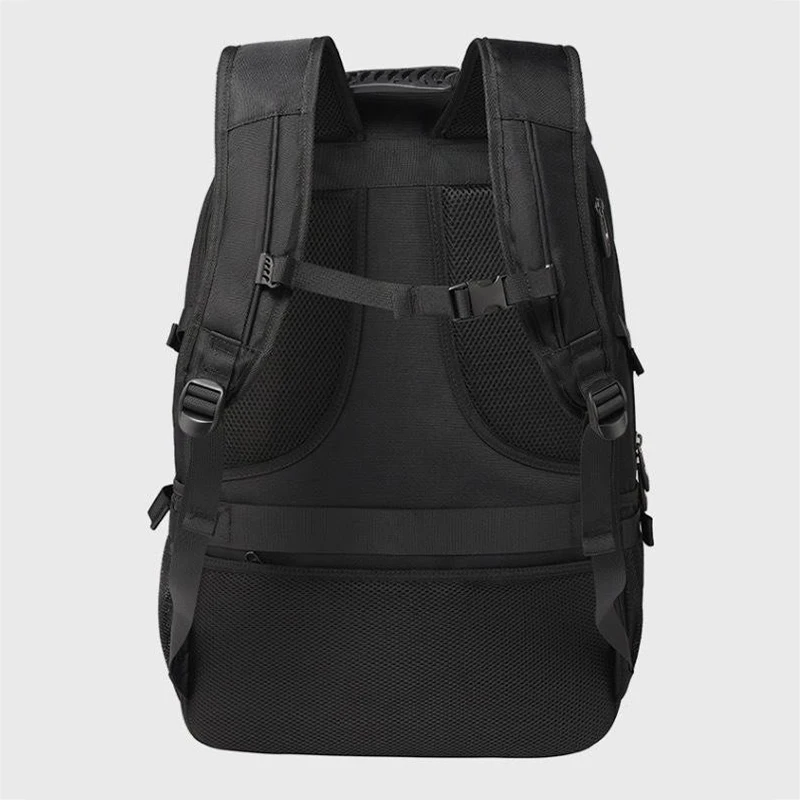
Main Compartment Design Options
The way your backpack opens fundamentally affects packing efficiency and access:
Clamshell Opening: Opens like a suitcase, allowing full visibility of contents and easy organization. Ideal for travelers who reorganize frequently or need quick access to items throughout the pack.
Top-Loading Design: Traditional backpack opening with access from the top. Better for security in crowded areas as it limits access points, but requires more digging to reach items at the bottom.
Hybrid Designs: Combine a main top-loading compartment with side or back panel access to lower sections. These women’s leather travel backpacks offer balanced security and accessibility.
Consider how you typically access your belongings when traveling. If you frequently need specific items without unpacking everything, multiple access points become invaluable.
Tech Protection: Laptop and Tablet Compartments
For modern travelers, electronic protection is essential:
Padded Laptop Sleeves: Look for suspended designs that keep your device from hitting the ground when the bag is set down.
Size Compatibility: Ensure compatibility with your specific devices – most 15-inch leather laptop backpacks also accommodate smaller devices, but verify measurements.
Accessibility: Consider whether you need quick access to your laptop (like at security checkpoints) or prefer it securely tucked away.
Multiple Device Storage: Separate compartments for tablets and laptops prevent devices from scratching each other.
Internal Organization: A Place for Everything
Thoughtful internal organization reduces travel stress by making items easy to find:
Document Sleeves: Flat pockets for passports, boarding passes, and travel documents keep important items accessible but secure.
Zippered Mesh Pockets: Ideal for small items that tend to get lost – chargers, adapters, earbuds, and medications.
Pen Holders and Card Slots: Small organizational features that make a big difference for business travelers.
Key Clips: Secure attachment points prevent keys from sinking to the bottom of your bag.
The best organization systems anticipate travel needs without overcomplicating the bag with unnecessary dividers that consume space.
External Quick-Access Features
When traveling, certain items require frequent access:
Front Pockets: Ideal for items needed during transit – phone, tickets, small snacks, or hand sanitizer.
Side Pockets: Usually designed for water bottles or compact umbrellas.
Hidden Back Pocket: Secure storage against your back for valuables like passport or wallet in crowded areas.
The key is balancing accessibility with security – features that make it easy for you to access items should not make it equally easy for others.
Comfort and Ergonomics for All-Day Wear
Even the most beautifully designed leather backpack becomes useless if it’s uncomfortable during long travel days. Quality leather backpacks designed for travel incorporate ergonomic features that distribute weight properly and prevent fatigue.
Travel often involves carrying your backpack for much longer periods than daily commuting – through airports, train stations, while sightseeing, or navigating unfamiliar cities. These extended wearing times make comfort features not just nice-to-have but essential.
14 Inch Leather Laptop Backpack, Brown Leather Backpack, Men's Leather Backpack, Vintage Leather Backpack
Price range: $177.28 through $199.12 Select options This product has multiple variants. The options may be chosen on the product pageCarry On Leather Backpack, Roll Top Leather Backpack
Price range: $77.76 through $96.48 Select options This product has multiple variants. The options may be chosen on the product pageDesigner Men's Backpack, Men's Leather Laptop Backpack, Men's Leather Work Backpack
Price range: $158.04 through $160.04 Select options This product has multiple variants. The options may be chosen on the product pageDesigner Mini Backpack, Mini Leather Backpack, Small Leather Sling Backpack, Women's Leather Backpack
Price range: $95.76 through $98.80 Select options This product has multiple variants. The options may be chosen on the product pageDesigner Mini Backpack, Designer Women's Backpack, Mini Leather Backpack, Women's Leather Backpack
Price range: $135.92 through $137.64 Select options This product has multiple variants. The options may be chosen on the product page15 Inch Leather Laptop Backpack, Leather Briefcase Backpack
$332.96 Select options This product has multiple variants. The options may be chosen on the product page
Shoulder Strap Engineering
The primary weight-bearing components of any backpack deserve particular attention:
Adequate Padding: Look for high-density foam that compresses minimally under weight but remains flexible.
Width Distribution: Wider straps distribute weight across more surface area, reducing pressure points.
S-Curve Design: Straps that follow the natural contour of your shoulders and chest provide better fit and comfort.
Adjustability: Multiple adjustment points allow customization for different body types and load weights.
Breathable Materials: Mesh backing or strategic ventilation channels reduce sweat buildup during extended wear.
Back Panel Design and Airflow
The back panel significantly impacts comfort during long travel days:
Contoured Design: Panels that follow the natural curve of your spine improve weight distribution and comfort.
Ventilation Channels: Air channels or mesh panels reduce sweat buildup and discomfort in warm conditions.
Padding Placement: Strategic padding at lower back (lumbar) region provides crucial support for heavier loads.
These features become particularly important when traveling in varied climates or when your backpack will be worn for extended periods.
Weight Distribution Features
Additional features that improve how weight is carried include:
Sternum Straps: These small straps connect the shoulder straps across your chest, stabilizing the load and preventing shoulder strain.
Load Lifters: Straps that connect the top of the shoulder straps to the backpack, allowing you to adjust how closely the pack sits to your upper back.
Optional Waist Belts: For larger travel backpacks, a removable waist belt transfers weight to your hips, substantially reducing shoulder and back fatigue.
Proper weight distribution becomes increasingly important as your travel load gets heavier or your travel days get longer.
Alternative Carrying Options
Versatility in carrying methods is valuable during different travel scenarios:
Padded Top Handle: Essential for lifting the pack in and out of overhead bins or carrying briefly by hand.
Side Handles: Allow briefcase-style carrying for professional environments or tight spaces.
Trolley Strap: Pass-through panel that slides over luggage handles for easy transport with rolling luggage.
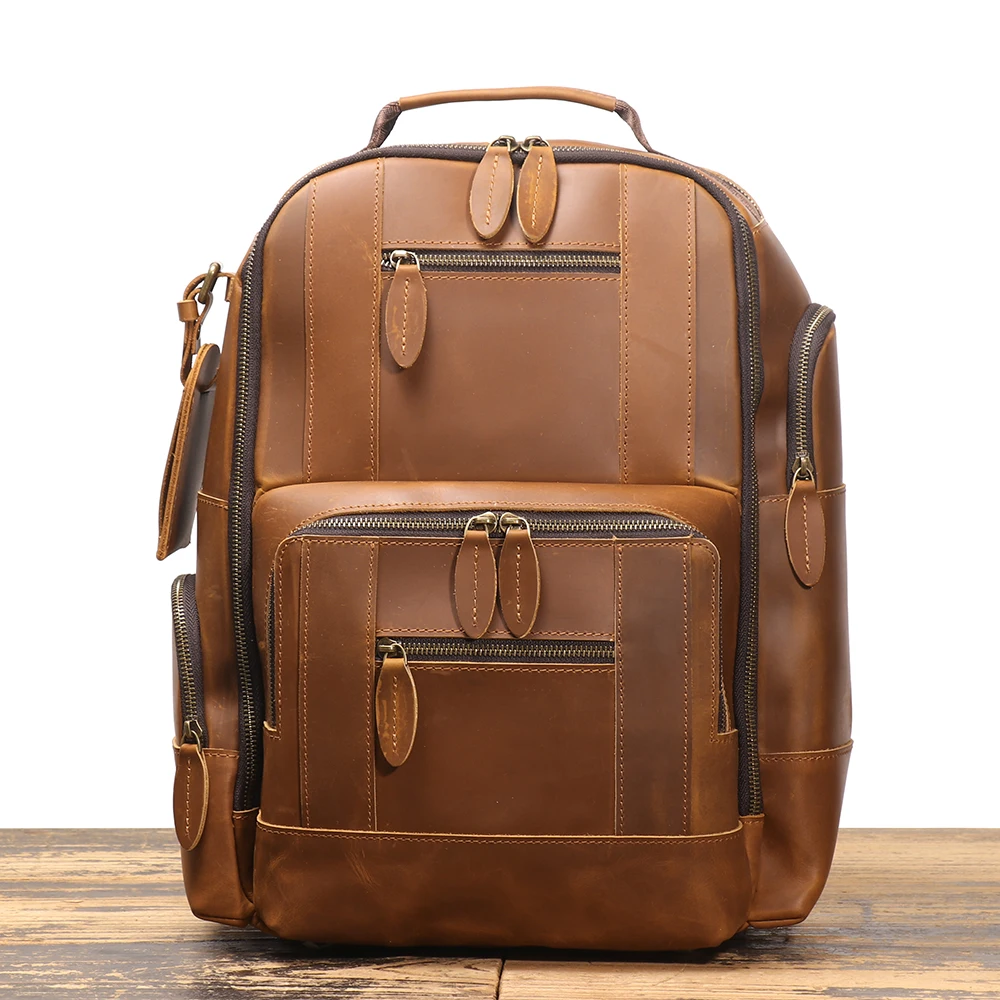
Security Features for Peace of Mind
Security concerns vary widely depending on your destination, but all travelers benefit from backpacks designed with protection in mind. The best security features deter opportunistic theft without significantly impacting your convenience.
Modern travel backpacks balance security with accessibility, recognizing that features too cumbersome to use regularly will be bypassed, defeating their purpose. Thoughtful security integration makes protection part of your routine rather than an extra step.
Secure Closure Systems
How your backpack closes directly impacts both security and convenience:
Lockable Zipper Pulls: Look for zippers with loops that accommodate small travel locks, especially for main compartments.
Covered Zippers: Flaps or overlays that conceal zipper pulls make casual access more difficult for pickpockets.
Magnetic Closures with Secondary Security: Magnetic snaps provide quick access but should be paired with more secure closures for main compartments.
Roll-top leather backpacks offer excellent security as they lack external zippers on the main compartment and typically require multiple steps to access.
Anti-Theft Design Elements
Subtle design features can significantly improve security:
Hidden Zipper Paths: Zippers positioned against your back or under flaps rather than on the exterior face of the backpack.
Slash-Resistant Materials: Reinforced bottom panels or hidden steel mesh in critical areas prevents cutting attacks.
RFID Blocking Pockets: Protected compartments for passports and credit cards prevent electronic scanning.
Discreet Branding: Less conspicuous designs without flashy logos or obvious indicators of expensive contents.
Hidden Storage Compartments
Strategic placement of hidden compartments balances security and accessibility:
Back Panel Pockets: Compartments that rest against your back when worn are virtually inaccessible to others.
Interior Hidden Pockets: Secured pockets within main compartments add an extra layer of protection for valuables.
False Bottoms or Dividers: Some premium designs include completely concealed compartments for high-value items or emergency cash.
Travel-Specific Convenience Features
Beyond the basics, certain features are specifically designed to address common travel challenges. These thoughtful additions often distinguish true travel-ready backpacks from general-purpose bags.
These convenience elements address pain points experienced during actual travel scenarios rather than hypothetical situations. They result from understanding how travelers interact with their bags throughout different stages of a journey.
Luggage Integration
For travelers using multiple bags, integration features save energy and simplify movement:
Pass-Through Sleeve: A panel on the back that slides over rolling luggage handles, allowing your backpack to rest securely on top of your suitcase.
Compression Straps: These allow you to secure the backpack to other luggage when needed.
Balance Design: Well-designed pass-through sleeves position weight properly to prevent tipping when attached to rolling luggage.
Airline Compatibility and TSA Considerations
For frequent flyers, compatibility with airline and security requirements is essential:
Carry-On Compliant Dimensions: Most airlines accept bags up to 22” x 14” x 9” (56 x 36 x 23 cm) as carry-ons, though exact requirements vary by carrier.
Quick-Access Laptop Compartments: Designs that allow laptop removal without unpacking the entire bag streamline security screening.
Compressibility: The ability to compress a partially-full bag to fit under seats or in overhead bins with limited space.
Weight Management Strategies
Leather naturally weighs more than synthetic materials, so thoughtful design minimizes unnecessary weight:
Strategic Material Placement: Using leather primarily for exterior panels while employing lighter materials for internal structure.
Hardware Selection: Choosing aluminum components instead of steel where strength requirements allow.
Hybrid Construction: Some travel-ready designs use leather only where it adds value (front panels, stress points) and lightweight materials elsewhere.
These weight-saving measures become particularly important for carry-on luggage where weight restrictions apply.
Style and Aesthetics for Versatile Travelers
While functionality is paramount, the aesthetic appeal of leather backpacks represents one of their most significant advantages. The ideal travel backpack navigates different environments without looking out of place, whether you’re in a business meeting or a casual cafe.
The timeless appeal of well-designed leather goods means your backpack won’t look dated after a season or two, unlike trendy synthetic options. This lasting style aligns with the executive style backpack features valued by professionals who travel frequently.
Design Versatility Across Travel Contexts
A truly versatile travel backpack adapts to different settings:
Professional Environments: Clean lines, minimal external hardware, and structured silhouettes convey professionalism for business travelers.
Casual Settings: Rich leather textures and patina development add character appropriate for casual exploration.
Urban to Outdoor Transition: Weatherproofing features and durable construction allow use beyond purely urban environments.
This adaptability is particularly valuable for dual-use leather bags that serve multiple purposes during a single trip.
Color Selection and Its Impact
Color choice significantly affects both versatility and maintenance:
Classic Black: Maximum versatility for business settings, shows less dirt and wear, but scratches may be more visible.
Rich Brown Tones: Develop beautiful patina over time, bridge formal and casual settings effectively, and often hide minor scuffs better.
Tan or Cognac: Casual yet sophisticated, showcase natural leather grain beautifully, though may show dirt more readily.
Navy or Dark Green: Modern alternatives to black that remain professional while offering distinctive character.
Darker colors typically offer greater versatility across different environments while lighter shades develop more visible patina.
Choosing the Right Travel-Ready Leather Backpack for Your Needs
Matching Backpack Features to Your Travel Type
Different travel styles demand different features from your leather backpack:
| Travel Type | Priority Features | Secondary Considerations | Examples |
|---|---|---|---|
| Business Travel | Professional appearance, laptop protection, organization for documents, luggage pass-through | Weight, weather resistance | Structured design, multiple internal compartments, subdued colors |
| Leisure Travel | Comfort for all-day wear, versatile capacity, easy access to essentials | Style versatility, security features | Flexible capacity, comfortable straps, quick-access pockets |
| Adventure Travel | Weather resistance, durability, ergonomic design | Weight, security features | Reinforced construction, water-resistant treatment, robust hardware |
| Mixed-Use | Adaptable design, convertible features, balanced organization | Optimal capacity, professional-casual crossover | Modular organization, versatile carrying options, classic styling |
For frequent business travelers, leather laptop backpacks with professional aesthetics and excellent organization make ideal travel companions.
Prioritizing Features Based on Travel Habits
To identify your most important features, consider these questions:
- How long are your typical trips? (Determines ideal capacity)
- What electronics do you regularly carry? (Influences protection features)
- What climates do you typically travel through? (Affects weatherproofing needs)
- How much walking do you do with your backpack? (Impacts comfort priorities)
- Do you typically check bags or travel carry-on only? (Affects size requirements)
- What security concerns exist in your frequent destinations? (Determines security features)
By analyzing your actual travel patterns rather than hypothetical needs, you can identify which features deserve priority in your selection process.
Understanding the Investment: Budget Considerations
Quality leather backpacks represent a significant investment, but their longevity often justifies the expense:
- Entry-Level Quality: $150-$250 – Often genuine leather or lower-grade full-grain/top-grain with basic features
- Mid-Range Quality: $250-$400 – Better leather quality, improved hardware, thoughtful design features
- Premium Quality: $400-$800+ – Highest-grade materials, exceptional craftsmanship, comprehensive features
When evaluating cost, consider the “cost per use” calculation. A $400 backpack used weekly for 10 years costs about 77 cents per use – often less expensive in the long run than replacing lower-quality bags multiple times.
Care and Maintenance for Travel Durability
Essential Cleaning and Conditioning Practices
Regular maintenance dramatically extends your leather backpack’s lifespan:
- Clean after travel: Wipe down with a slightly damp cloth to remove dust and surface dirt, paying special attention to creases and seams.
- Allow complete drying: Never store leather damp or use direct heat sources for drying.
- Condition regularly: Apply quality leather conditioner every 3-6 months or whenever the leather feels dry (more frequently in dry climates).
- Treat hardware: Occasionally clean metal components and apply zipper lubricant to maintain smooth operation.
These simple leather maintenance practices for commuters apply equally well to travel contexts and prevent premature aging or damage.
Protection Strategies for Travel Hazards
Proactive protection prevents damage in challenging travel conditions:
Water Protection: Apply appropriate leather waterproofing products before trips, especially to rainy destinations. Understanding whether oiling leather provides waterproofing helps you choose the right protection strategy.
Sun Protection: Minimize extended exposure to direct sunlight which can dry and fade leather. When not in use, store your backpack away from windows and heat sources.
Structure Maintenance: Use paper or a light packing when storing to help maintain shape between trips.
Spill Response: Address any spills immediately by blotting (never rubbing) and allowing natural drying before conditioning.
Storage Best Practices Between Trips
Proper storage between adventures preserves your backpack’s quality:
- Store in a breathable cloth bag (not plastic) in a cool, dry place away from direct sunlight
- Stuff with acid-free tissue paper to maintain shape and prevent creasing
- Apply leather conditioner before extended storage periods
- Leave zippers partially open to prevent stress on closure mechanisms
- Keep in a climate-controlled environment when possible to prevent mold or excessive drying
Is a Travel-Ready Leather Backpack Worth the Investment?
For most travelers seeking a blend of functionality, durability, and style, quality leather backpacks justify their higher initial cost through:
- Extended Lifespan: Quality leather backpacks often outlast synthetic alternatives by 5-10 years with proper care.
- Improved Travel Experience: Better organization, comfort, and reliability reduce travel stress and solve common pain points.
- Versatility Across Settings: The ability to use one bag across different environments eliminates the need for multiple specialized bags.
- Developing Character: Unlike synthetic bags that look worn and dated over time, leather backpacks develop character and often look better with age.
For frequent travelers, professionals who value aesthetics, or anyone who appreciates quality craftsmanship, the investment delivers value far beyond the initial purchase price.
What Should You Avoid When Selecting a Leather Travel Backpack?
Watch for these warning signs that often indicate inferior quality:
- Vague Leather Descriptions: Terms like “genuine leather” without specifying grain type often indicate lower quality materials.
- Unfinished Edges: Raw edges without proper finishing will fray and deteriorate quickly.
- Plastic Hardware: Critical components made from plastic rather than metal suggest poor durability.
- Weak Stitching: Single stitching at stress points or inconsistent stitch patterns indicate poor construction.
- Excessive Weight: Unusually heavy backpacks may use filler materials or low-quality heavy leather.
- Strong Chemical Smell: Quality leather has a pleasant natural scent; strong chemical odors suggest poor tanning or finishing processes.
- Unrealistic Discounts: Extremely low prices compared to similar products typically indicate compromises in materials or construction.
How Can You Tell If a Leather Backpack Will Last Through Years of Travel?
Look for these quality indicators when evaluating potential travel companions:
- Edge Finishing: Properly finished and sealed edges resist fraying and moisture infiltration
- Reinforced Stress Points: Double stitching or rivets at handles, strap attachments, and bottom corners
- Quality Hardware: Solid metal zippers, buckles, and fixtures that operate smoothly
- Consistent Stitching: Even, tight stitching with no loose threads or irregularities
- Interior Construction: Clean seams, secure attachment of lining, and thoughtful organization
- Weight Distribution: Even weight when empty, suggesting balanced construction
- Detailed Craftsmanship: Attention to small details like strap reinforcement and interior finishing
When examining Summit Carry backpacks, you’ll notice these quality indicators that signal long-lasting performance through years of travel adventures. By investing in a properly constructed leather backpack with features aligned to your specific travel needs, you gain not just a bag but a reliable travel companion that improves with every journey.

